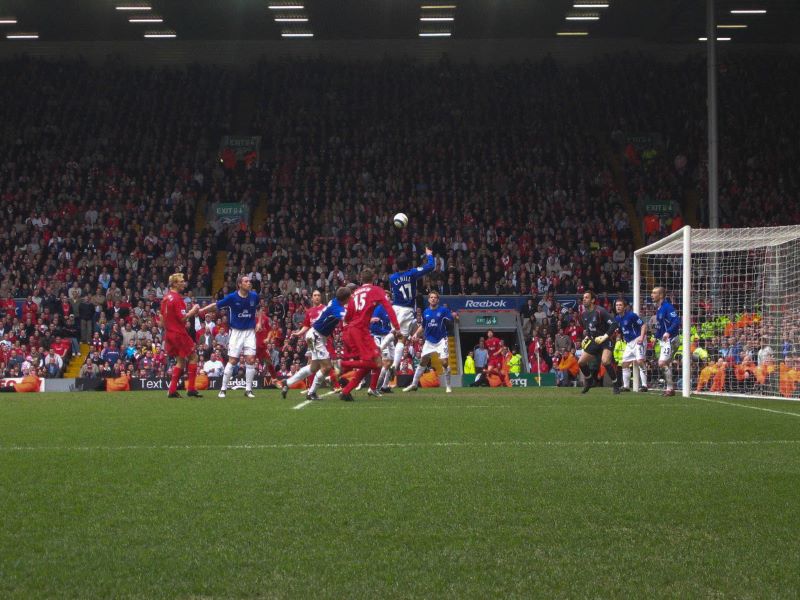Table of Contents
ToggleLiverpool vs Everton (Merseyside Derby) Head to Head
Location: Liverpool
Teams: Everton, Liverpool
First meeting: 13 October 1894, First Division, Everton 3–0 Liverpool
Stadiums: Anfield (Liverpool), Goodison Park (Everton)
Total matches: 242
Liverpool wins: 98
Everton wins: 67
Top scorer: Ian Rush, 25 goals
The Merseyside Derby: Liverpool vs Everton, a fixture that sums up the very essence of football rivalry. With its rich history, deep-seated emotions, and dramatic moments, this matchup between Liverpool’s two of the most popular English football clubs, has captivated football fans worldwide.
Today, we will dive into the Merseyside Derby, so, let’s get started!
A Friendly Derby?
The Merseyside derby earned the moniker “friendly derby” for an intriguing reason – it was one of the few fixtures that didn’t enforce total fan segregation. Played continuously since the 1962-63 season, this derby has a unique aura.
The close proximity of Everton’s Goodison Park and Liverpool’s Anfield (less than a mile apart), with Stanley Park in between, symbolizes the intense rivalry. Yet, even in the heat of battle, this fixture has often transcended into a celebration of football itself.
Origins of the Merseyside Derby
The roots of this fierce rivalry go back to the late 19th century when two of the most followed Premier League football clubs, Everton and Liverpool were established. Everton, founded in 1878, initially played their matches at Anfield, owned by club chairman John Houlding.
However, political and financial disputes within Everton’s board led to a split, prompting the creation of Liverpool FC in 1892. The split, driven by differences in ownership structures and political affiliations, set the stage for the Merseyside derby.
Politics played a significant role in this rivalry. Everton’s board members were linked to the Liberal Party. In contrast, Houlding and Liverpool’s founder, aligned with the Conservative Party.
This divergence in political ideologies contributed to the clubs’ separation. Moreover, religious affiliations, with Everton gaining a reputation as the “Catholic club” and Liverpool as the “Protestant club,” added an intriguing layer to the rivalry.
However, it’s essential to note that the city of Liverpool had a diverse and mixed fanbase, and support for both clubs transcended these divisions. Both Everton and Liverpool welcomed fans from various backgrounds and denominations.
Unity in Tragedy
Tragedy has, at times, brought these two clubs together. In the aftermath of the Heysel Stadium disaster, Liverpool and Everton were banned from European club competitions, despite Everton’s lack of involvement. However, the relationship improved significantly after the Hillsborough disaster.
Fans rallied together in solidarity, and the Merseyside community united during these trying times. Evertonians even joined Liverpool supporters in boycotting “The Sun” newspaper. These moments showed the deep camaraderie that transcends club rivalry in Liverpool.
Nowadays Merseyside Derby
The Merseyside derby has evolved over the years, with both clubs experiencing periods of success and dominance. In the 1960s, Liverpool and Everton were regular contenders for domestic trophies. Still, Liverpool surged ahead during the 1970s and 1980s, while Everton went through a relatively barren spell.
However, Everton’s fortunes changed with the appointment of Howard Kendall as manager in 1981. The rivalry intensified during this period, with both clubs competing for league titles and cup honors. The 1985-86 season, in particular, stands out, as Liverpool and Everton battled for both the league title and the FA Cup.
In recent years, Liverpool, one of the richest football clubs in the world, has largely dominated the Merseyside derby. Notably, in the 2018-19 season, Divock Origi’s dramatic last-minute goal, following a mistake by Everton’s goalkeeper Jordan Pickford, etched itself into derby folklore. Liverpool’s 2-0 victory in February 2021 ended Everton’s long-standing Anfield drought, marking a significant moment in the rivalry.
In the 2020-21 season, the derby saw VAR controversy, further underlining the drama that consistently surrounds this fixture. The 2021-22 season witnessed Liverpool’s resounding 4-1 away victory, reminding everyone of the club’s dominance in this historic clash.
Head to Head Stats
The head-to-head statistics between Liverpool and Everton reflect the closely contested nature of this derby. Liverpool has the edge with 98 wins, while Everton boasts 67 victories. Draws have played a significant role in the derby’s history, with 77 matches ending without a clear winner. In terms of goals, Liverpool has scored 341, compared to Everton’s 267.
In terms of honors, Liverpool holds a distinct advantage. The club has won 19 First Division/Premier League titles, 8 FA Cups, 9 EFL Cups, 16 Community Shields, 6 UEFA Champions League titles, 3 UEFA Europa League titles, 4 UEFA Super Cups, and 1 FIFA Club World Cup. Everton, on the other hand, has secured 9 First Division/Premier League titles, 5 FA Cups, and 9 Community Shields.
Conclusion
The Merseyside derby between Liverpool and Everton is more than just a football fixture. It’s a reflection of a city’s history, culture, and passion for the sport. While the rivalry has had its share of controversies and fierce battles, it’s also been a symbol of unity in times of tragedy. As football fans, we can only look forward to more memorable moments and dramatic encounters in this iconic fixture.
Merseyside Derby is a clash of two great teams, Liverpool and Everton, who share a history as rich as the game itself. From the “friendly derby” days to the intense battles on the modern pitch, this rivalry has seen it all.
So, whether you’re a Red or a Blue, the Merseyside Derby is a date to circle on your calendar. It’s a celebration of football, passion, and the city of Liverpool itself. Get ready for more unforgettable moments, because this rivalry is as alive and exciting as ever!


